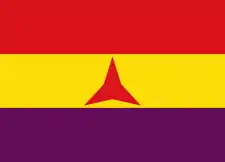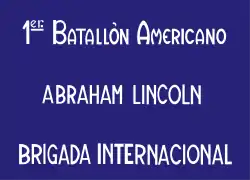XV International Brigade
The Abraham Lincoln Brigade (Spanish: Brigada Abraham Lincoln), officially the XV International Brigade (XV Brigada Internacional), was a mixed brigade that fought for the Spanish Republic in the Spanish Civil War as a part of the International Brigades.
| XV International Brigade Abraham Lincoln Brigade | |
|---|---|
 | |
| Active | 1936–1939 |
| Country | United States, United Kingdom, Canada, Ireland, Bulgaria, Greece, Yugoslavia, France, Belgium, and Cuba |
| Allegiance | |
| Branch | |
| Type | Mixed Brigade – Infantry |
| Role | Home Defence |
| Size | Four battalions: the 16th, 17th, 18th and 19th (January 1937) |
| Part of | 35th Division (1937–1939) |
| Garrison/HQ | Albacete, Barcelona |
| Nickname(s) | Brigada Abraham Lincoln |
| March | Jarama Valley and Viva la XV Brigada |
| Engagements | Spanish Civil War |
| Commanders | |
| Notable commanders | Janos Galicz Vladimir Ćopić Robert Hale Merriman Milton Wolff Veli Dedi |
| Part of a series on |
| Anti-fascism |
|---|
 |
The brigade mustered at Albacete in Spain, in January 1937, comprising mainly English-speaking volunteers – arranged into the mostly British Saklatvala Battalion and the mostly North American Lincoln Battalion. It also included two non-English-speaking battalions, the Balkan Dimitrov Battalion and the Franco-Belgian Sixth February Battalion. It fought at Jarama, Brunete, Boadilla, Belchite, Fuentes de Ebro, Teruel and the Ebro River.
The brigade's songs were "Jarama Valley" and "Viva la Quince Brigada".[1]
History
The XVth Brigade first fought at the Battle of Jarama in February 1937 and suffered many casualties. The British lost 225 men out of 600,[2] the Lincolns 120 out of 500.[3] After the battle, the brigade was seriously under-strength.
At the end of March, a Spanish battalion, Voluntario 24 (the 24th Volunteers), joined the brigade. Over the next few months, under the close supervision of Janos Galicz, the brigade was re-organised into two regiments of about 1,200 men. He appointed "the gallant major",[4] George Nathan, as brigade Chief of Staff.
The first regiment, commanded by Jock Cunningham, with Harry Haywood as political commissar,[5] was English-speaking and comprised the depleted British and Lincolns, as well as the recently formed but under-strength second battalion of American volunteers, the George Washington Battalion. The second regiment was commanded by Major "Chapaiev" (Mihaly Szalvay)[5] and consisted of the Dimitrov Battalion, the Sixth February Battalion and the Voluntario 24 Battalion.
This was the composition in July 1937 for the Battle of Brunete. As with the Battle of Jarama, the brigade suffered huge casualties; the brigade strength was reduced from six to four battalions. In particular, the two American battalions were so depleted that they merged to form the Lincoln-Washington Battalion.[6] (This name did not last: it was renamed the Lincoln Battalion in October 1937.) The 6 February, which also suffered severe casualties, was transferred after Brunete. After Belchite, the nominally Canadian Mackenzie-Papineau Battalion joined the brigade, while the Dimitrov Battalion departed.
During the fall of 1937 the units of the International Brigade were integrated into the Spanish Popular Army and the Battalions were re-numbered. The British Bn became the 57th, the Lincoln-Washington the 58th, the Spanish (formerly known as the 24th), became the 59th and the Mackenzie-Papineau the 60th. The battalion line-up remained stable through the withdrawal of the Internationals during the Ebro Campaign.
The XVth International Brigade also included volunteers from Latin America,[7] who, after incidents of bad treatment from North Americans, left the international Brigades and joined other units such as El Campesino's First Mobile Shock Brigade.[8][9]
After an invitation from J. B. S. Haldane,[10] American singer and activist Paul Robeson traveled to Spain in 1938 because he believed in the International Brigades' cause,[11] visited the hospital of the Benicàssim, singing to the wounded soldiers.[12] Robeson also visited the battlefront[13] and provided a morale boost to the Republicans at a time when their victory was unlikely.[11]
On 13 March 2015, Dan Kaufman interviewed Del Berg, a 99-year-old veteran of the Abraham Lincoln Brigade, who he described as the last known survivor of the Brigade.[14] Berg died 28 February 2016.[15]
Overview of battalions

Date joined Number Battalion Name Composition Date left Comments 31 Jan 1937 16th/57th Saklatvala Battalion British, Irish, Dominion 23 Sep 1938 Demobilized 31 Jan 1937 17th/58th Lincoln Battalion American, Canadian, Irish, British 23 Sep 1938 Demobilized 31 Jan 1937 18th Dimitrov Battalion Bulgarian, Greek and Yugoslav 20 Sep 1937 Moved to 45th Div. Reserve 31 Jan 1937 19th Sixth February Battalion French and Belgian 4 Aug 1937 Moved to 14th Brigade 14 Mar 1937 24th/59th Voluntario 24 Battalion Cuban 10 Nov 1937 Moved to a Spanish Mixed brigade 29 Jun 1937 60th Mackenzie-Papineau Battalion American and Canadian 23 Sep 1938 Demobilized 4 Jul 1937 20th Washington Battalion American 14 Jul 1937 Merged with Lincoln Battalion[16]
- Sub-battalion units attached to the Brigade
- Brigade Anti-Tank Company
- XVth Brigade Photographic Unit (Aug 1937 – Sep 1938) Archive
- Connolly Column
Notable members
- Delmer Berg – American political activist
- Edward A. Carter Jr. – American Medal of Honor recipient
- Theodore Cogswell – American science fiction writer
- Fred Copeman – English battalion commander
- Milan Ćopić – Yugoslav prison warden
- Vladimir Ćopić – Yugoslav brigade commander
- Jock Cunningham – Scottish battalion commander
- Petar Dapčević – Yugoslav commander
- Malcolm Dunbar – British chief of staff
- Ralph Fasanella – American painter
- Janos Galicz – Hungarian division commander
- William Herrick – American novelist
- Jack Jones – English company commissar
- Oliver Law – American battalion commander
- James Maley – Scottish political activist
- Roland Masferrer – Cuban political activist
- Robert Hale Merriman – American brigade chief of staff
- Conlon Nancarrow – American-Mexican composer
- George Nathan – British brigade chief of staff
- Paddy O'Daire – Irish battalion commander
- Abe Osheroff – American activist
- Edwin Rolfe – American commissar
- William Lindsay Gresham – American novelist, volunteer medic
- Frank Ryan – Irish commissar
- Milton Wolff - American author, and commander of the Lincoln Battalion
See also
References
Citations
- Viva la Quinta Brigada was unfortunately misnamed in the 1970s song "Viva la Quinta Brigada" by Christy Moore.
- Beevor (2006), p. 211.
- Beevor (2006), p. 214.
- Thomas (2001), p. 693.
- Eby (2007), p. 174.
- Eby (2007), p. 196 "... losses in killed and wounded approached four hundred out of close to eight hundred just eight days before..."
- "Abraham Lincoln Brigade: Spanish Civil War History and Education: The War in Spain". Alba-valb.org. Retrieved 12 October 2017.
- "Spaniards and Latinos in the International Brigades - The Volunteer". Albavolunteer.org. 7 February 2011. Retrieved 12 October 2017.
- Petrou, Michael (2008). Renegades: Canadians in the Spanish Civil War, p. 109-110. UBC Press. ISBN 9780774858281.
- Beevor (2006), p. 356.
- Wyden (1983), pp. 433–34.
- "Paul Robeson". Rutas Culturales. Archived from the original on 30 October 2016. Retrieved 29 October 2016.
- Beevor (2006), p. 356; cf. Eby (2007), pp. 279–80, Landis (1967), pp. 245–46
-
Kaufman, Dan (13 March 2015). "The Last Volunteer". The New York Times Magazine. p. MM38. Retrieved 16 March 2015.
Del Berg, 99, is the last known surviving veteran of the Abraham Lincoln Brigade, a contingent of nearly 3,000 Americans who fought to defend the democratically elected government during the Spanish Civil War of the 1930s.
- Roberts, Sam (3 March 2016). "Delmer Berg, Last of American Volunteers in Spanish Civil War, Dies at 100". The New York Times. p. A21. Retrieved 3 March 2016.
- Briefly known as the Washington-Lincoln Battalion
Sources
- Books
- Beevor, Antony (2006). The Battle for Spain.
- Bradley, Ken (26 May 1994). International Brigades in Spain 1936–39. Chappel, Mike (illus.). Elite. ISBN 978-1855323674.
- Good basic introduction to the subject in a readable and well-illustrated format. Author made several visits to battlefields and interviewed veterans in the 1980s and 90s.
- Eby, Cecil (2007). Comrades and Commissars.
- Landis, Arthur H. (1967). The Abraham Lincoln Brigade. Citadel Press.
- Thomas, Hugh (2001). The Spanish Civil War (4th Rev. ed.).
- Wyden, Peter (1983). The Passionate War: The Narrative History of the Spanish Civil War, 1936–1939. Simon and Schuster. ISBN 978-0671253301.
- Websites
- EPR Order of Battle Website (in Spanish)
- Associació Catalana Website (in Catalan)
Further reading
- Raeburn, Fraser (2022). "'The Surest of All Morale Barometers': Transnational Encounters in the XV International Brigade". Contemporary European History. 31 (1): 85–99. doi:10.1017/S0960777321000217. S2CID 237807295.
External links
- Abraham Lincoln Brigade Archives, Tamiment Library and Robert F. Wagner Labor Archives at NYU.
